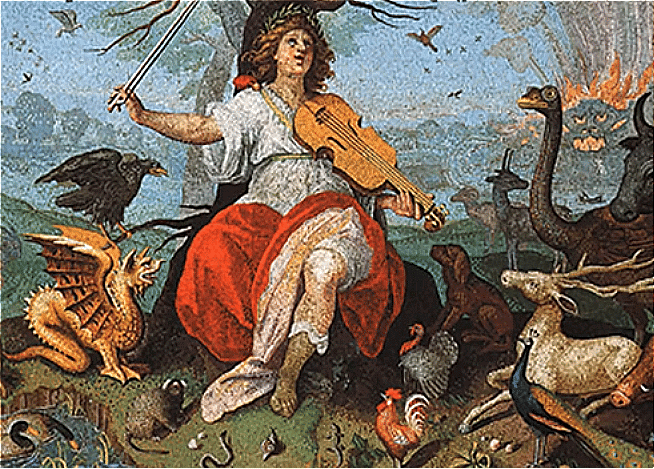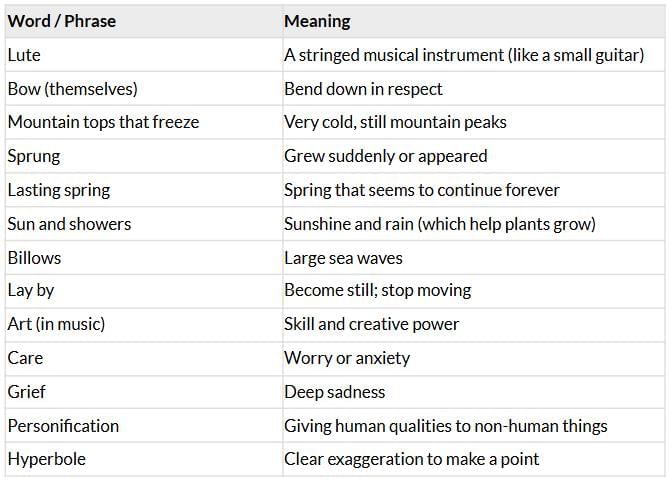Summary: Orpheus with His Lute | Gul Mohar Class 6: Book Solutions, Summaries & Worksheets PDF Download
| Table of contents |

|
| About the Poet |

|
| Detailed Summary (Stanza-by-Stanza Explanation) |

|
| Moral / Message |

|
| Vocabulary Table |

|
About the Poet
William Shakespeare (1564–1616) was an English playwright, poet, and actor, often called the greatest writer in English. He wrote famous plays like Hamlet, Macbeth, and The Merchant of Venice, and over 150 sonnets. This song appears in his play Henry VIII.
Detailed Summary (Stanza-by-Stanza Explanation)
Stanza 1
“Orpheus with his lute made trees,
And the mountain tops that freeze,
Bow themselves, when he did sing:”
Orpheus, a master musician from Greek myths, plays the lute (a string instrument). His music is so powerful that nature itself reacts. The trees seem to bend as if showing respect. Even the cold, high mountain tops, which are usually still and hard, appear to bow. Shakespeare uses personification to show that music can soften even the toughest things. The lines suggest deep admiration for the art of music.
Stanza 2
“To his music plants and flowers
Ever sprung; as sun and showers
There had made a lasting spring.”
Where Orpheus plays, plants and flowers seem to burst into life. It looks like spring lasts forever, not just one season. The poet compares music’s effect to sun and rain working together to make the earth fresh and blooming—this is a gentle simile (“as sun and showers”). Music is shown as life-giving, making everything around it grow. The mood is bright, warm, and hopeful.
Stanza 3
“Everything that heard him play,
Even the billows of the sea,
Hung their heads, and then lay by.”
Not only trees and flowers—everything listens, including the sea. The “billows” (waves) stop tossing and become calm; they “hang their heads” and “lay by” (become still). Again, Shakespeare uses personification to make waves behave like polite listeners. There is also a touch of hyperbole (exaggeration) to stress how strong the music’s charm is. The scene changes from movement to peaceful stillness.
Stanza 4
“In sweet music is such art,
Killing care and grief of heart
Fall asleep, or hearing, die.”
Here the poet explains the message: true music has healing power. Worries (“care”) and sadness (“grief”) are “killed”—not violently, but meaning they fade away. Music makes our troubles fall asleep or disappear when we listen. The word “art” reminds us that music is a skilled, thoughtful craft. The stanza turns the nature-magic into a human lesson: music soothes the mind and heart.
Moral / Message
Music has the power to calm, heal, and bring harmony. It can change the mood of people and even the “mood” of nature in the poem. By listening to good music, worries and sadness fade, and peace grows. The poem teaches us to value art and understand how beauty—like music—can make our world gentler and our minds happier.
Vocabulary Table

|
30 videos|61 docs|17 tests
|
FAQs on Summary: Orpheus with His Lute - Gul Mohar Class 6: Book Solutions, Summaries & Worksheets
| 1. What is the main theme of the poem "Orpheus with His Lute"? |  |
| 2. Who is Orpheus and what is his significance in mythology? |  |
| 3. How does the poet convey emotions through the imagery in the poem? |  |
| 4. What moral or message can be derived from "Orpheus with His Lute"? |  |
| 5. What literary devices are prominent in "Orpheus with His Lute"? |  |















